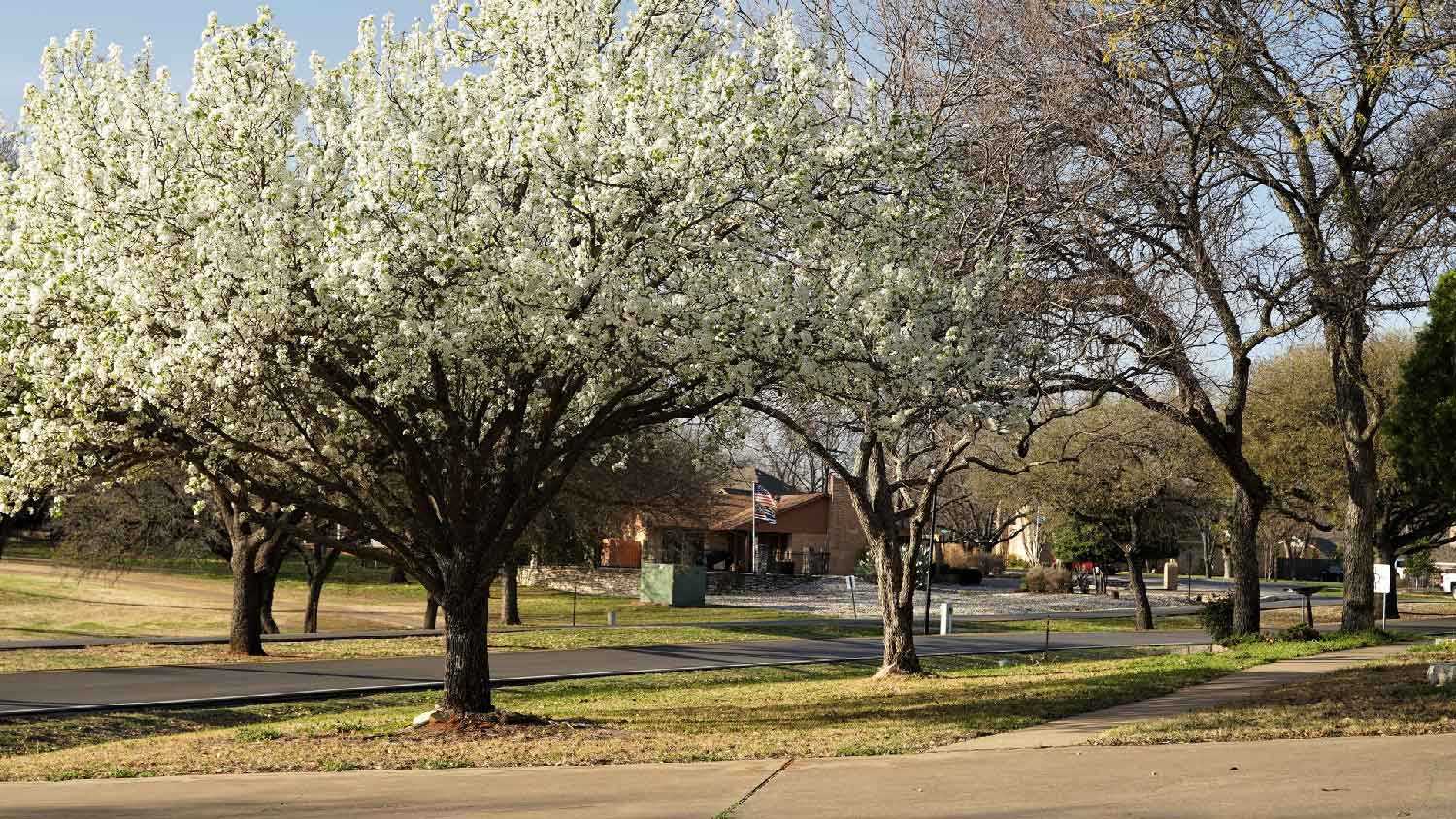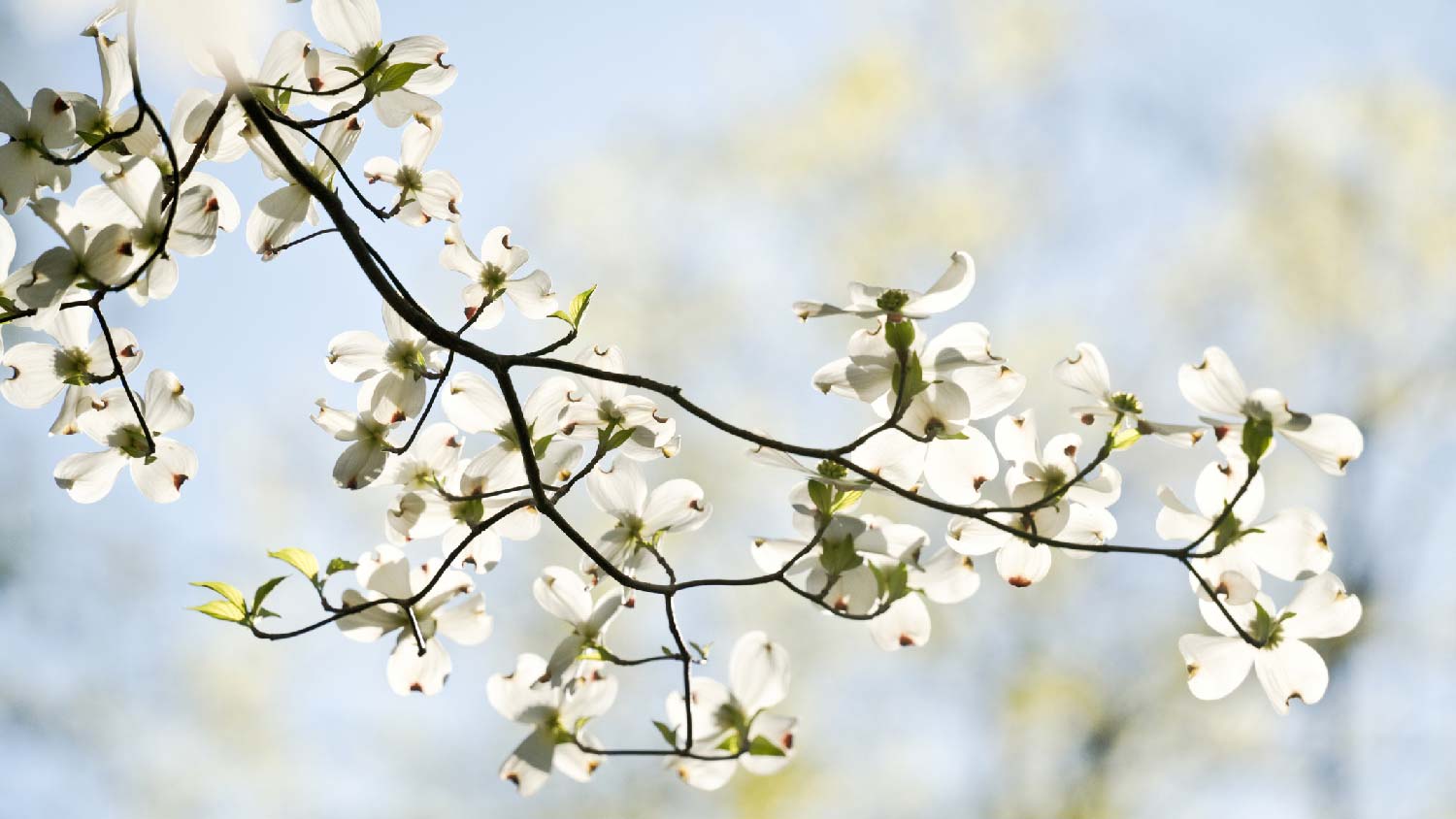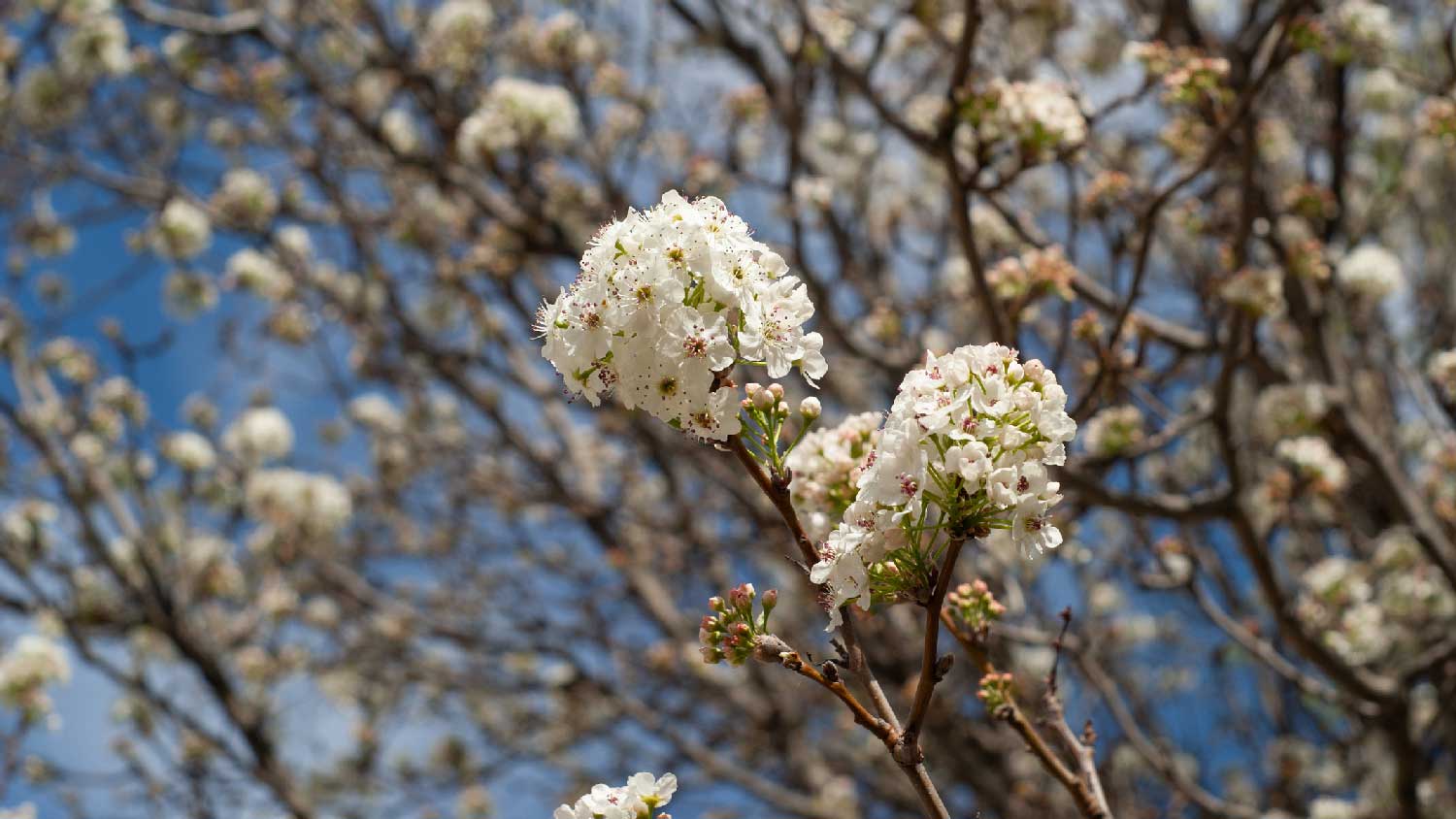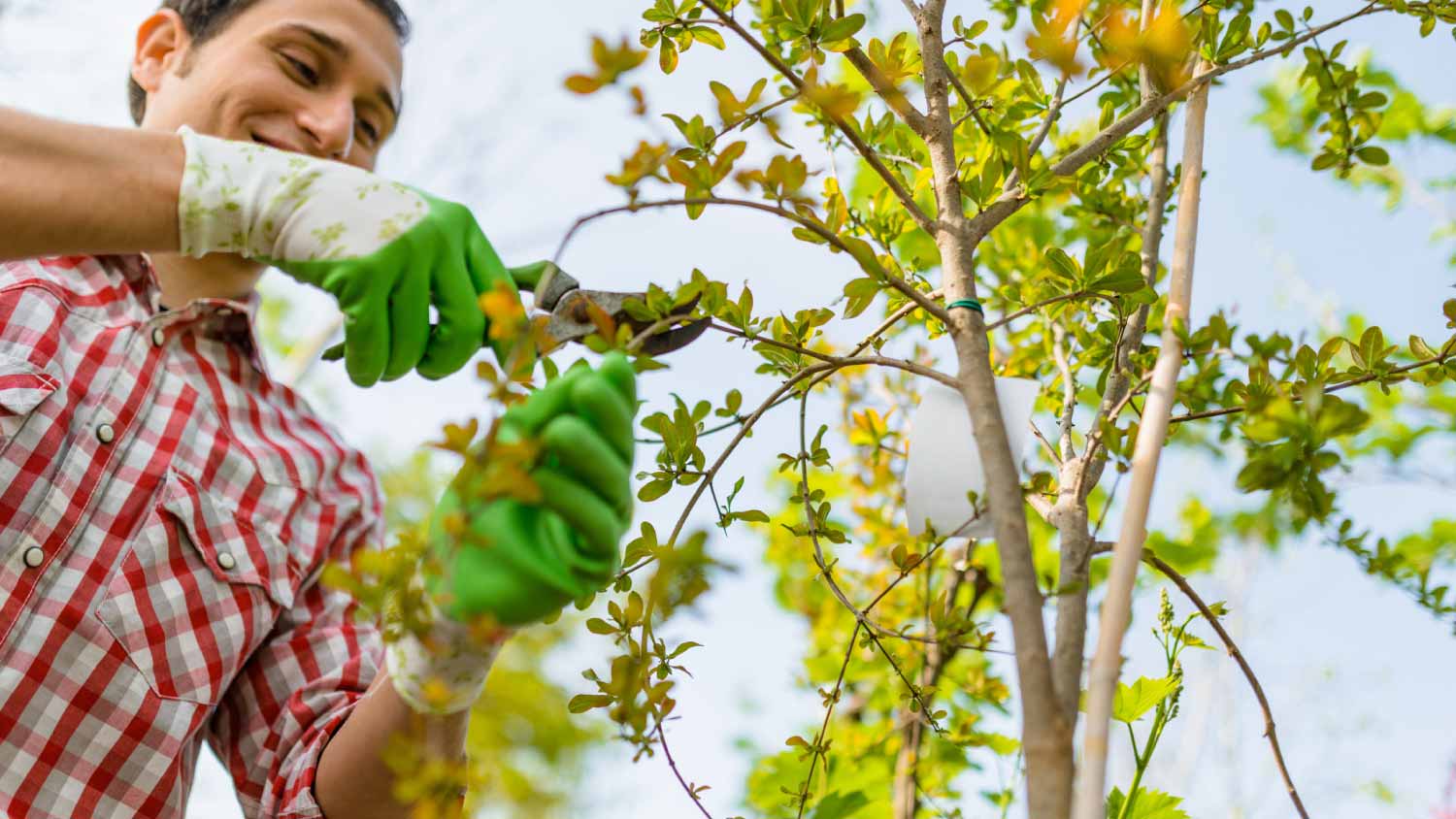Bradford Pear Tree vs. Dogwood: What’s the Difference?
These showy spring trees differ in significant ways


Both Bradford pears and flowering dogwoods have beautiful flowers.
Bradford pear trees were imported from Asia in the early 1900s.
Flowering dogwood trees are native to North America.
If you’re looking for an ornamental tree to add to your yard, Bradford pears and flowering dogwoods are both medium-sized trees with delicate white blossoms. Although they have some similarities, the two trees also have some key differences, including how quickly they grow and how long they last. Here’s everything you need to know to decide between a Bradford pear tree vs. dogwood.
Bradford Pear vs. Flowering Dogwood Tree: Key Differences
Bradford pear and flowering dogwood trees are both medium-sized ornamental trees favored by landscapers for their pretty white clusters of flowers in spring. The size of their blooms varies, with flowering dogwoods having three-inch-wide blossoms and Bradford pear trees having smaller, half-inch to one-inch blossoms. The appearance of the leaves also varies between the two, with flowering dogwood leaves being more fuzzy and Bradford pear leaves being more shiny. The Bradford pear also is not native to the U.S. and has a tendency to spread, while the flowering dogwood is a native species that is much more likely to be contained to where it’s planted. The dogwood tends to be a stronger tree, capable of withstanding gusts of wind, while the Bradford pear is more likely to be damaged in severe weather.
What Is a Bradford Pear Tree?

The ancestors of Bradford pear trees, a variety of Callery pear, were brought to North America from Asia in the early 19th century and were originally experimentally cultivated by the USDA. It became a popular ornamental tree in the 1950s because of its flowers, and the modern-day Bradford pear was introduced as a landscaping plant in 1961. These trees, when planted on their own, are sterile, making them a good choice for landscaping if you don’t want them to spread. They can, however, cross-pollinate with other varieties of Callery pear and spread quickly if not kept in check. While the flowers are pretty, they smell a little bit offensive, with people comparing the odor to wet gym socks or fish.
| Pros | Cons |
|---|---|
| Pretty white flowers | Smell like fish when in bloom |
| Simple to care for | Can split when allowed to grow too large |
| Resists disease and pests | Considered an invasive species |
Best For:
Bare yards that need fast-growing plants
Low-maintenance landscaping
Lawns that need a statement tree
Pros of Bradford Pear Trees
Bradford pear trees grow quickly to a manageable height of 15-25 feet. In spring, they produce beautiful white flowers that grow in clusters, and in the fall, their leaves turn bright red. Resistant to diseases and pests, the Bradford pear is sterile, which means it can’t self-pollinate.
Cons of Bradford Pear Trees
Bradford pear tree blossoms tend to have an undesirable odor. Additionally, the trees—which have a lifespan of about 20 years—have a tendency to split apart, especially if they grow to more than 30 feet tall, and their weak branches are vulnerable to storms. The Bradford pear was meant to be sterile but is now considered an invasive species because it can cross-pollinate with other types of Callery pear trees. Because they can spread and choke out native trees and shrubs, Bradford pear trees have been banned by some municipalities.
What Is a Flowering Dogwood Tree?

Native to eastern North America, the flowering dogwood is prized for its graceful branches and long-lasting white or pink flowers. It attracts songbirds and pollinators like honey bees. Flowering dogwoods usually reach a height of about 20-40 feet and have an average lifespan of about 80 years.
| Pros | Cons |
|---|---|
| Beautiful flowers | More specific soil requirements |
| Strong and sturdy | Need to be watered more |
| Attract native birds and pollinators | Slower growth |
Best For:
Adding elegant beauty to a landscape
Homeowners who want long-lived trees
Native gardens that support local insects and wildlife
Pros of Flowering Dogwood Trees
Since flowering dogwood trees are native to North America, they tend to be well adapted to the local environment. They produce beautiful, fragrant flowers in early spring as well as bright red fruit in the fall that’s a food source for native bird species.
Cons of Flowering Dogwood Trees
Flowering dogwoods need to be watered more often than Bradford pears, and they have more specific soil requirements, so they’re slightly more difficult to grow. You may want to hire a local tree maintenance pro to keep your flowering dogwood healthy. Dogwoods are also slow to medium rate growers, so if you’re looking for quick shade, these aren’t the trees for you.
Bradford Pear Tree vs. Dogwood Tree

Appearance: Tie
Dogwoods and Bradford pears are neck-in-neck for showy spring blooms, and they both have vibrant fall foliage as well.
Hardiness: Bradford Pear
Bradford pears are more drought tolerant and can grow in a wider range of soil conditions. Their adaptability gives them an edge over the flowering dogwood here.
Size: Tie
Bradford pear trees are slightly smaller than flowering dogwoods, but both types of trees are manageably-sized, growing to an average of 20 feet or so.
Strength: Dogwood
Flowering dogwood trees have wood that is dense and shock-resistant, making them stronger and more tenacious in storms as well as more stable as they grow.
Growth Speed: Bradford Pear
Bradford pears will grow quickly–over a foot per year–making them a very rapid grower. Since they grow so quickly, they’re a popular choice for homeowners who need extra shade in a hurry.
Longevity: Dogwood
Flowering dogwood trees live an estimated 80 years, outlasting Bradford pears by decades.
Frequently Asked Questions
You should prune ornamental trees once every other year after the fruit has matured and begun to drop. You should also prune out dead branches whenever you see them. Pruning too often can stimulate more growth, especially in faster growing varieties like Bradford pears.
For Bradford pears, damage from storms is common, and if the trunk splits, it can pose a danger to people and surrounding structures. The best thing to do in that instance is to have the tree removed. If there’s only minor damage to the branches, pruning away the damaged parts is the first order of business. You may also want to consult a professional arborist to make sure the tree is healthy.
Consulting your local university extension, Audubon society, or municipal urban forestry program are all good ideas when choosing a tree to plant. You can also ask an arborist or a knowledgeable landscaping company for advice on good trees to plant.





- Why You Should Avoid Bradford Pear Trees—and What to Plant Instead
- 14 Incredibly Invasive Trees to Avoid Planting on Your Property
- 9 Ways to Protect Your Trees From Winter Storms
- The Power of Trees: Learn Which Ones Can Make Your Property Value Flourish
- Can You Cut Down a Tree on Your Property?
- How to Tell What Type of Tree You Have in Your Yard
- How to Choose Between a Real or an Artificial Christmas Tree
- 10 Great Trees for Bees and Other Pollinators
- What Does a Maple Tree Look Like?
- Can You Trim Trees in the Summer?










